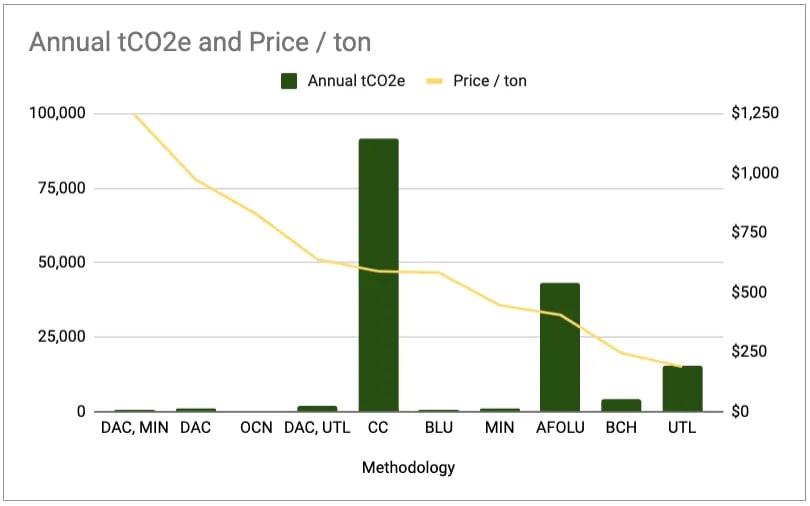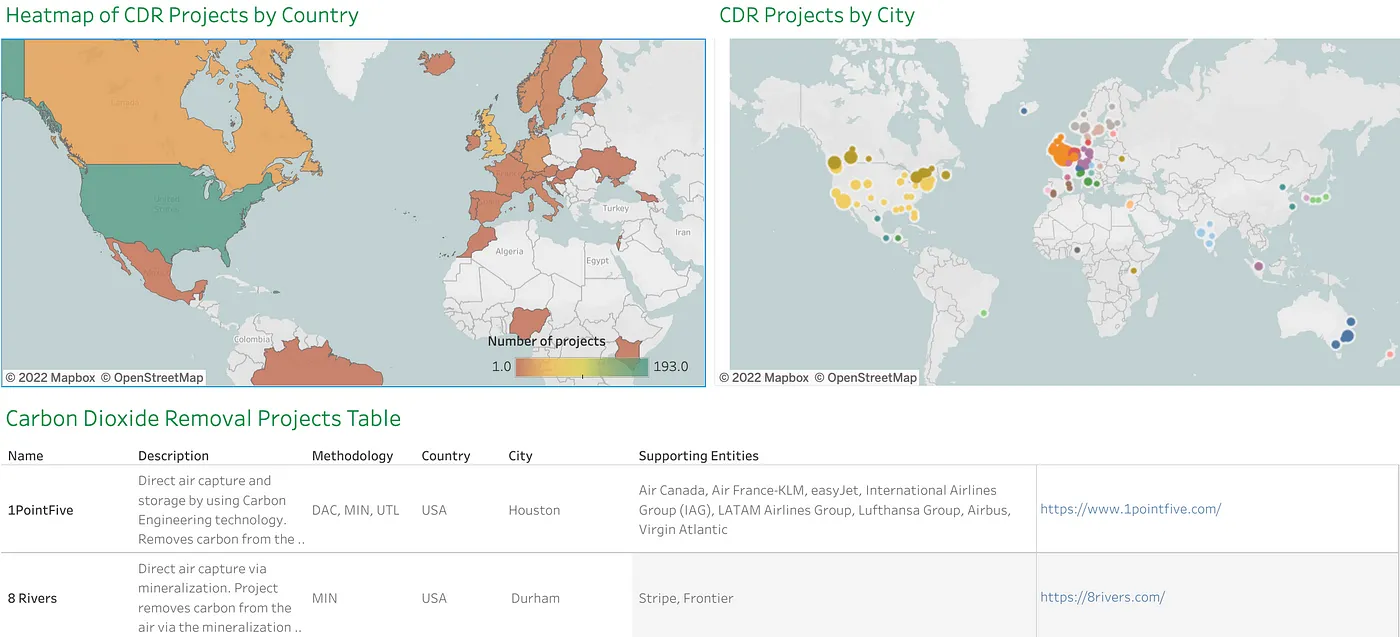
As a summer project, AlliedOffsets waded into the world of carbon dioxide removal (CDR). Here are some things we’ve learned — supplemented, as usual, with unique data insights.
At the start of the summer, I made it a goal to learn as much as possible about CDR. The technology to reverse climate change seems so close, yet so far away: I wanted to understand just how much progress has been made, how much farther to go, and get a sense for what some of the companies in the space are doing.
Below are some things I learned as part of my research. The output is a list of 400+ companies and projects taking place around the world. They range from enhanced weathering for long-term CO2 storage, via biochar and BECCS, to modular direct air capture (DAC) technologies. We’ve made most of our research available to the public here; subscribers to the our premium dashboard can get data on volumes and pricing, where available.
As I am not a chemical engineer or an environmental scientists (and as I spent 6 weeks looking into something that others study for years), you should take any and all of my opinions with a grain of salt. However, it is clear the future of carbon offsetting is heading in the direction of verifiable, permanent avoidance and removals, rather than projects that measure sequestration or avoidance against a baseline that, by definition, can never be known.
We hope this directory helps companies identify new projects to support, promotes collaboration, and allows the market to grow and mature.
1. The CC technology has existed for a long time…but new uses and uses are emerging almost daily
Capturing carbon from point source is a known technology; in fact, the first plant was proposed nearly 100 years ago. That’s both good and bad: good, in that the processes are known and generally well-understood; and bad, in that we’ve not figured out how to make it viable in decades.
While point source CO2 capture has been around, there are new companies entering this space almost daily. Instead of simply capturing the carbon, they are thinking about how to store it permanently or use it in products, avoiding the need to extract more fossil fuels from the ground. It’s an exciting time, and everyone from governments to large corporates is thinking about how they can support the nascent industry.
2. Carbon credits can play a big role
Unfortunately, the reason for carbon capture not having taken off before is that it’s not economical: CO2 has simply not been valuable enough to capture and use. A mechanism like carbon offsetting can be a great financial supplement to make it worthwhile for companies to capture and store or use the CO2 they generate. Some companies are already making use of this, and are offering credits to interested parties.
3. Many ‘CDR’ projects are better described as avoidance than removals
The last year and a half has seen a growing debate between avoidance vs. removals credits. Traditionally, ‘avoidance’ has meant something like renewables or cookstoves, providing a more energy-efficient method that avoids a ton of carbon generated by deforestation or coal burning from entering into the atmosphere. The counterfactual is difficult to measure or prove, so some in the market had gravitated to ‘removals’ (for the most part, planting new trees) as a more verifiable or credible offset. However, the CDR projects we looked at seem to have put this divide behind them.
In general, the projects can be grouped in three categories:
- capturing carbon,
- storing it,
- and / or using it in applications like fuel or consumer goods.
While some firms focus on removing carbon, many technologies are using CO2 in ways that mean the companies are avoiding it from entering the atmosphere. On top of that, even companies that capture CO2 from the atmosphere may sell it on to be used in conventional ways, like food production, which will eventually make it back into the atmosphere. In other words, unless a company is both capturing and using/storing the carbon permanently, it is more likely to be an avoidance credit.
4. The role of the traditional registries is in flux
What does this all mean for registries like Verra, Gold Standard, American Carbon Registry, and Climate Action Reserve (among dozens of others)? The industry seems to be going in three directions:
- Some companies, like CarbonCure and neustark have developed methodologies that make use of the existing carbon offsetting infrastructure to generate credits and allow corporates to offset in ways they’ve done in the past. This means corporates can offset their emissions using the same systems they are used to, and have a degree of trust in the legacy systems the registries have established.
- Others, like biochar firms, have partnered with a new registry (Puro.earth) in order to offer their carbon credits there. That has the benefit of working with a registry and standard-setting body that is well-versed in their technology, and doesn’t require the time and resources to develop a new methodology.
- Others still have eschewed the existing model of establishing a methodology to compare a project against, to create their own registry of buyers and offsets. The flagship example here is Charm Industrial, which shows the carbon credits it has issued to companies on its custom registry. These firms are able to generate credits and enable corporate offsetting quickly, but it also means there is less public scrutiny of the activities taking place.
It’s an interesting development, and it remains to be seen how existing registries react to the entrants.
5. Data
Finally, the numbers. The below data comes primarily from information companies submitted to Stripe, Shopify, Klarna, Microsoft and Frontier; often, these are the only numbers that are available. We supplemented this data with information coming from the companies’ sites, especially around the number of tons that may be available. The caveat here is, many of these technologies are in the earliest stages, and below are companies where we have at least 2 samples. But there is a need for more data sharing and standardising in order to make more meaningful conclusions.

Not surprisingly, anything to do with DAC is at the top of the chart, while nature-based solutions, which exist today, are lower down: the costs are much higher for new technologies. And the scale of the intervention tends to be inverse to price: the lower the cost, the higher the tonnage.
You can see a full list of how we’ve broken down the methodologies below. This is our own taxonomy for the projects, which we decided to create, given the lack of consistency among sources.

Feedback is very much welcome, so please don’t hesitate to comment below or reach out to anton.root@alliedoffsets.com to share your thoughts!
Resources
Here are some resources we’ve found valuable as part of this research:
- Carbon180 — A lobbying and information group for US projects.
- American University — A fantastic resource to better understand the technologies involved.
- CarbonPlan — As always doing great work in the carbon sector, their work on Microsoft and Stripe RFPs inspired this research.
- Corporates and Governments: Stripe, Microsoft, Shopify, Klarna, XPrize, Frontier (made up of Stripe, Alphabet, Shopify, Meta, McKinsey), BEIS, others — Leading innovation, these stakeholders are providing a key role in creating demand for processes that would not have been viable for years (if not decades) otherwise.
- List of Known CDR Purchases — Robert Höglund has aggregated a helpful list of company CDR purchases / commitments.
- MCJ — A great podcast (and community) that goes into deep conversations with CDR business founders and how they are looking to change the world.
